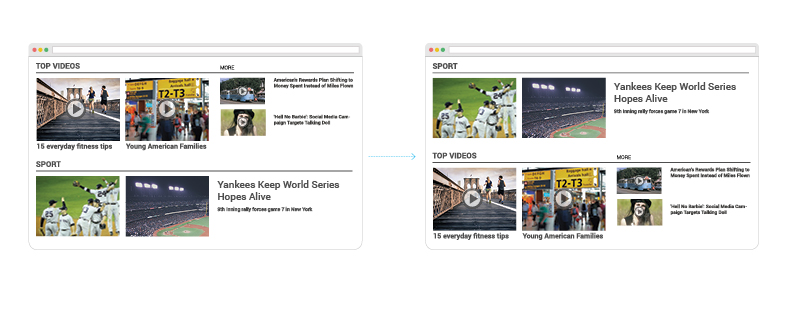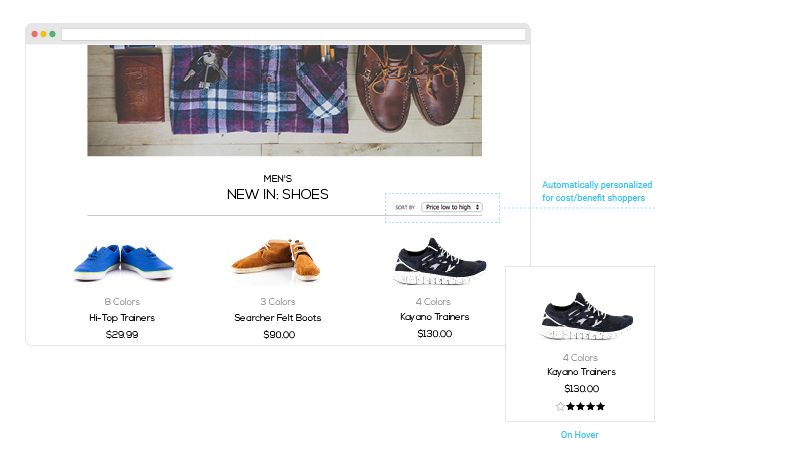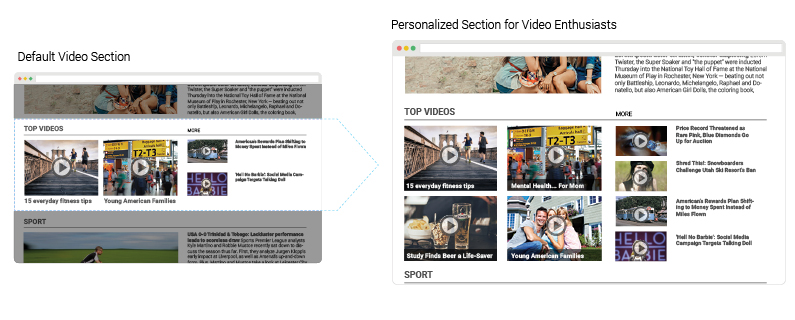Personalizing websites with dynamic content layouts
Is the one-size-fits-all web design on its way to extinction? Discover why layout personalization is a driving force for increasing engagement and revenue. Here are three powerful ways to immediately benefit your existing site.
Summarize this articleHere’s what you need to know:
- Personalization is key: One-size-fits-all web design is no longer effective. Personalizing layouts based on individual customer preferences is crucial for boosting engagement and revenue.
- Micro-personalization matters: Go beyond basic personalization and tailor layouts to each customer’s unique actions and preferences.
- Three key tactics: Dynamically reorder content and product categories, personalize product grids, and automatically extend content sections based on individual preferences.
- Personalized product grids: Showcase products in a way that resonates with each shopper, expediting purchases and increasing revenue.
- Content for enthusiasts: Extend content sections for users who show interest in specific categories, driving deeper engagement and ad revenue.
Using web personalization to win over customers is all the hype. But there’s virtually no talk about personalizing site layout and it’s shocking that there isn’t.
Successful marketers know that reducing exit rates, increasing time-on-site, and boosting page and product views are all crucial to online success. They work hard to create appealing and eye-catching layouts that deliver the most engaging user experience. You’ve taken customer feedback and implemented it into your decision making. You’ve tirelessly tested page elements, messaging, color schemes, call to actions (CTAs), and content arrangements. You’ve milked every inch of your digital real estate and developed a structure that drives conversions and revenue.
But there’s one major problem.
Without layout personalization, your experience optimization efforts will remain forever generalized, only relevant for the average user. The fact is that there is no uniform site structure that can provide an optimal user experience to each of your visitors. No two users are the same, and while your existing and awesome layout may be attuned to the desires of most people, it simply can’t be for everyone. If you don’t personalize your site’s layout, you are limiting possibilities for engagement and missing out on a tremendous revenue opportunity.
How do I start personalizing page payout?
The speed of online innovation is such that it’s nearly impossible to personalize site layout without the help of an automated solution that eliminates all the guesswork. Today you can employ a sophisticated personalization platform with predictive analytics that automatically tailors and transforms the layout according to the preferences of individual user segments.
Marketers need to start thinking about site layout on a micro level, aligning strategic initiatives with each customer’s unique actions and personal preferences. Layout personalization empowers you to bring the products and content your visitors have come for to the forefront of their on-site experience, streamlining engagement, and fully maximizing the uplifts you’ve set out to achieve. Here are a few ways to utilize layout personalization to immediately benefit your site without having to rebuild or redesign it.
Three ways to personalize layout
Dynamically re-order content and product categories
Your homepage is the gateway to your site and showcases your highest-valued content and products. Your visitors gravitate towards and interact with the categories that interest them most and you can dynamically restructure content or product categories in real-time according to the affinities of your readers and viewers. If a user has a demonstrated interest in sports content, for instance, then the entire sports content section can be automatically moved up or situated ahead of the other content categories. The same can be done for any product category—depending solely on your user’s preferences.
 Bottom line: Dynamically re-ordering content and product categories according to user preferences will allow your visitors to find what they’ve come for and fast.
Bottom line: Dynamically re-ordering content and product categories according to user preferences will allow your visitors to find what they’ve come for and fast.
Personalize grids on product pages
eCommerce brands must always look to find a balance between presenting too much product information and providing just enough detail to entice buyers to complete the purchase. However, buyer preferences, motivations and interests often vary tremendously: while some shoppers are cost-benefit oriented and consistently filter for lower-end or cheaper products, others are ‘brand fans,’ interested in the newest, best-selling or top-rated ones.
Instead of defaulting search results to a ‘featured products’ page, retailers can utilize user-generated search data to personalize results automatically, arranging product grids according to each user’s buying preferences. If a user constantly filters according to rating, for instance, they can automatically be presented with a default sorting order that features the highest-rated products first.
Further, tracking each user’s buying preferences enables retailers to efficiently manage the flurry of visual factors that typically go into product descriptions, such as color, price, and rating. Presenting all this information at once on your product grid can distract your visitors from the element of the purchase that means the most to them.
If a user has a demonstrated interest in price, then that can be highlighted above all else in the product presentation. To illustrate, one of our clients discovered that not showing color options upfront and displaying ratings only on hover to cost-benefit shoppers led to a significant increase in average order value (AOV), RPV, and conversion rate.
Bottom line: Personalizing your product grid according to individual buying preferences expedites and maximizes the purchase, as it presents your offerings in the exact way your shoppers want to see them and brings them one step closer to checkout.
Automatically extend content sections
For publishers, more engagement means more eyeballs and more eyeballs means more ad revenue. Personalizing content layout for publishing sites boils down to increasing views by enhancing the content categories your visitors love and continuously interact with.
For example, let’s say you’re a publisher looking to increase revenue from pre-roll ads (commercials that appear before online videos), and your path towards achieving this goal is to increase overall video views. One way to accomplish this is by implementing personalized video sections that automatically extend their layout for users with a high interest in video content.
If a user has viewed five or more videos in the past seven days, for instance, they will be automatically presented with double the number of videos and content recommendations within the sections they interact with most.
Bottom line: Extending content sections for enthusiasts of that content category will encourage more engagement throughout your site and contribute a substantial amount of additional ad revenue. This strategy is not limited to video content and can be done for any prominent article or product category as well.
Conclusion
Layout personalization empowers you to bring the products and content your visitors have come for to the forefront of their on-site experience and maximizes the uplifts you’ve set out to achieve. As a single user experience will not work for everyone, layout personalization technology is the driving force for increasing engagement and revenue. It’s important to keep in mind that each site is ultimately unique in its design and goals and while some strategies might work for some they might not work for others. Consider this post a starting point for your layout personalization efforts.


